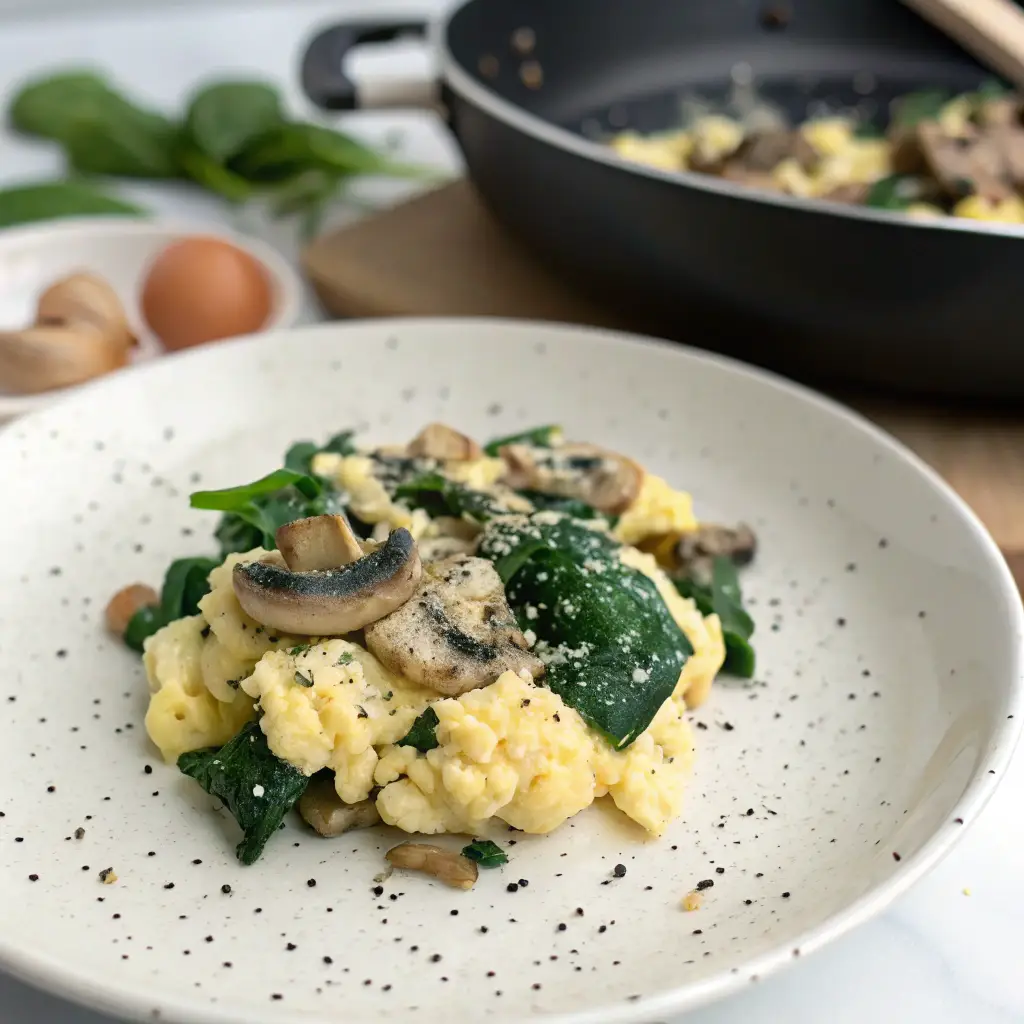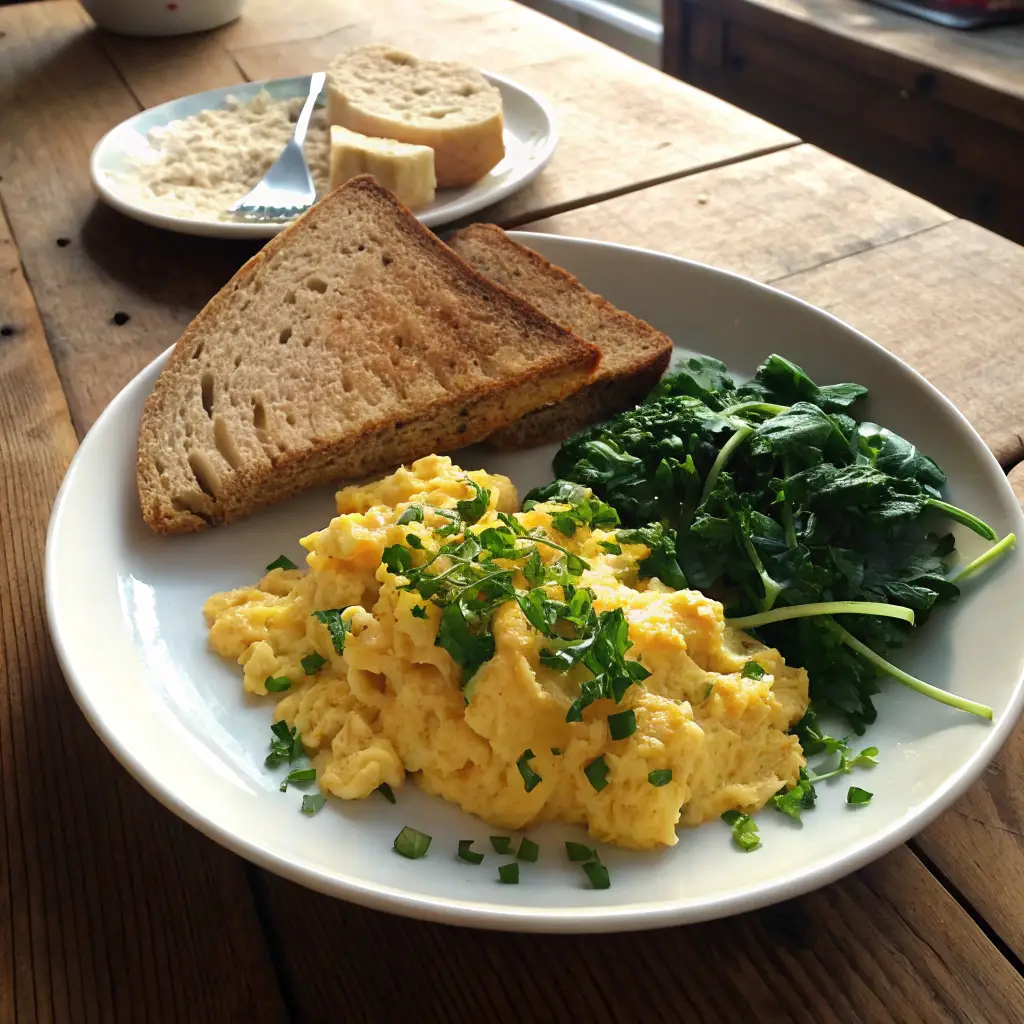Let’s talk scrambled eggs—one of the simplest, tastiest, and most versatile breakfast options out there! But here’s the thing: they’re not all created equal. Depending on how you cook them, what you add, and the portion size, the calorie count can swing pretty wildly. This article’s got the goods on everything you need to know about scrambled eggs calories—from the basics to how they fit into your diet (whether you’re cutting carbs, building muscle, or just trying to eat healthier). We’ll keep it fun, relatable, and packed with practical tips, so grab your whisk, and let’s dive in!
Table of Contents
The Basics of Scrambled Eggs Calories
What Are Scrambled Eggs?
Ah, scrambled eggs—the breakfast MVP. They’re made by whisking eggs (sometimes with a splash of milk or water) and cooking them over gentle heat until they’re soft, fluffy, and golden. This dish is a go-to because it’s quick, customizable, and works for just about anyone’s taste buds. Plus, they’re a protein-packed option that can keep you satisfied for hours.
Here’s the kicker, though: the way you make scrambled eggs can totally change their calorie count. A couple of plain eggs? Pretty light on calories. Throw in butter, cheese, or cream? You’ve got yourself a caloric upgrade.
Calorie Count in Standard Scrambled Eggs
Let’s break it down real quick:
- One Large Egg (Scrambled): About 90 calories—7g protein, 6g fat, and less than 1g carbs.
- Two Eggs with Milk and Butter: Around 200–250 calories depending on how much fat you add.
Those numbers might not seem like a lot, but when you start tossing in extras (hello, shredded cheese and crispy bacon), things can add up fast.If you’re looking for a more detailed breakdown of scrambled eggs’ nutritional information, including variations like added milk or butter, check out the resource provided by FatSecret Scrambled Eggs Nutrition. It’s a trusted platform for accurate calorie counts and nutrient insights.
Factors That Change the Calorie Game
- Cooking Fats: Butter (100 calories per tablespoon) or oil (120 calories per tablespoon) are easy calorie boosters. Use non-stick pans to skip added fats altogether.
- Liquid Add-ins: Adding a tablespoon of milk adds just 9 calories, while cream packs a heftier 52 calories.
- Extras: Cheese? Oh, boy. A sprinkle might only add 20–30 calories, but a handful? Try 100+.
- Serving Size: Two eggs double the calories of one—go figure!
Why Scrambled Eggs Are Still a Win
Despite the calorie variations, scrambled eggs are a nutrient-dense choice. They’re loaded with:
- Protein for keeping you full.
- Vitamin D for your bones.
- Choline for brain health.
Plus, they’re ridiculously quick and easy to make. A two-minute meal that’s healthy? Sign us up.
Scrambled Eggs and Your Health
Are Scrambled Eggs Good for You?
Oh, absolutely! Scrambled eggs are like that trusty friend who’s always got your back—nutritious, versatile, and super satisfying. They’re packed with high-quality protein (about 7 grams per large egg) and essential nutrients like vitamin D, choline, and selenium. These nutrients play key roles in keeping your bones strong, boosting brain health, and supporting your immune system.
Now, you might’ve heard about the “egg and cholesterol debate.” Here’s the truth: for most folks, moderate egg consumption doesn’t harm heart health. In fact, newer studies suggest the cholesterol in eggs has minimal impact on your blood cholesterol levels. So, unless your doctor says otherwise, scrambled eggs can stay on the menu!
Macronutrients in Scrambled Eggs
When it comes to nutrition, scrambled eggs are the real deal. They strike a great balance of protein, fats, and essential vitamins, making them a solid choice for any meal.
- Protein Powerhouse: Eggs are full of complete protein, meaning they contain all nine essential amino acids. This is why they’re great for muscle repair and growth.
- Healthy Fats: A single scrambled egg has about 6 grams of fat. Most of it is unsaturated—the good kind that helps support your heart and brain.
- Low Carbs: Scrambled eggs have virtually no carbs, making them an excellent choice for keto or low-carb diets.
Comparing Scrambled Eggs to Other Egg Preparations
All eggs are great, but the way you cook them can make a difference nutritionally—and calorie-wise.
- Boiled Eggs: A single boiled egg has about the same calories as scrambled eggs, but without the added fats from cooking. They’re ideal for when you’re counting calories.
- Fried Eggs: Fried eggs are typically cooked in oil or butter, which can add anywhere from 50 to 120 extra calories.
- Poached Eggs: These are cooked in water, making them the lightest option calorie-wise, but not quite as flavorful as scrambled.
At the end of the day, scrambled eggs strike a nice middle ground—tasty and nutrient-rich with just a touch of indulgence, depending on how you prepare them.
Customizing Scrambled Eggs for Your Diet
Low-Calorie Scrambled Egg Options

If you’re watching calories but still want a hearty breakfast, scrambled eggs can easily fit into your diet. It’s all about smart swaps and simple tweaks.
- Egg Whites Only: Want to cut back? Ditch the yolks! Each egg white has just 17 calories and still offers protein, though you’ll miss out on some vitamins found in the yolk.
- Non-Stick Pans: Skip the butter or oil and use a non-stick pan. This can save you 100–120 calories.
- Low-Cal Add-Ins: Instead of cheese or cream, mix in chopped veggies like spinach, mushrooms, or tomatoes—they add flavor and nutrients without many calories.
High-Protein Scrambled Egg Recipes
For those looking to fuel up, scrambled eggs can be a protein-packed powerhouse.
- Spinach and Feta Scramble: Add fresh spinach (low in calories but high in fiber) and a sprinkle of feta for a tangy boost. This combo hits about 200 calories per serving.
- Turkey and Egg Scramble: Toss in lean turkey sausage for an extra 10 grams of protein without overloading on calories. A serving comes in at around 250 calories.
Looking for more ways to add protein to your scrambled eggs? Try pairing them with leftover rotisserie chicken for a flavorful and high-protein boost. For creative ideas, check out our Creative Leftover Rotisserie Chicken Recipes for inspiration.
Enhancing Flavor Without Extra Calories
Here’s the fun part—you can jazz up your scrambled eggs without tipping the calorie scale.
Texture Additions: Chopped green onions or finely diced jalapeños add crunch and zing with almost no extra calories.
Spices and Herbs: Turmeric (anti-inflammatory), paprika, or fresh dill can add a ton of flavor with zero calories.
Low-Calorie Toppings: Salsa, hot sauce, or a sprinkle of nutritional yeast are flavorful options that won’t ruin your calorie goals.
Scrambled Eggs and Weight Management
How Scrambled Eggs Fit into a Weight-Loss Diet
Scrambled eggs are a perfect choice for anyone trying to shed a few pounds. Why? Because they’re low in calories but high in protein, which keeps you feeling full for hours. Protein reduces hunger hormones like ghrelin and increases satiety hormones, so you’re less likely to overeat later in the day.
For a weight-loss-friendly meal, keep things simple:
- Stick to one or two eggs and skip heavy add-ins like cheese or cream.
- Add low-calorie, nutrient-packed veggies like spinach, tomatoes, or mushrooms.
- Cook with a non-stick pan to avoid extra fat from butter or oil.
If you’re following a calorie deficit, scrambled eggs fit right in—pair them with a slice of whole-grain toast or a side of avocado for a balanced, satisfying breakfast.
Can Scrambled Eggs Help Build Muscle?
Yes, they can! Scrambled eggs are packed with high-quality protein, making them a favorite among gym-goers and athletes. Each large egg contains about 6–7 grams of protein, and that’s before you start adding extras like turkey sausage, cottage cheese, or smoked salmon.
For muscle-building meals, try these combos:
- Scrambled Eggs with Sweet Potatoes: A perfect post-workout meal combining protein and complex carbs for recovery.
- Egg and Avocado Wraps: Scrambled eggs wrapped in a low-carb tortilla with avocado slices for a protein and healthy fat punch.
Eggs are rich in leucine, an amino acid essential for muscle protein synthesis, so including them in your diet can help you gain and maintain lean muscle.
Calorie Tracking for Scrambled Egg Meals
Keeping track of your scrambled egg meals can be a game-changer if you’re trying to manage weight or meet specific fitness goals. Apps like MyFitnessPal or Cronometer can help you log ingredients and portion sizes accurately.
Here’s an example of a balanced scrambled egg meal:
- Two Scrambled Eggs (180 calories)
- Sautéed Spinach and Mushrooms (50 calories)
- Half an Avocado (120 calories)
- Slice of Whole-Grain Toast (80 calories)
Total: Around 430 calories for a satisfying, nutrient-dense breakfast or lunch.
Tips for Weight Management with Scrambled Eggs
- Plan Ahead: Prep your ingredients the night before for a quick, stress-free breakfast.
- Batch Cook: Make a large portion of scrambled eggs and store them in the fridge for 2–3 days—great for busy mornings.
- Measure Portions: Use measuring spoons for add-ins like butter or cheese to avoid accidentally increasing calories.
Scrambled eggs are versatile, easy to prepare, and perfect for supporting weight management. Whether you’re aiming to lose weight or gain muscle, they can be tailored to meet your goals.
FAQs About Scrambled Eggs Calories
How Many Calories Are in 2 Scrambled Eggs?
Two scrambled eggs typically contain about 180 to 200 calories. This number assumes the eggs are cooked with a small amount of butter or oil. If you add milk, cream, or cheese, the calorie count goes up depending on the portion size of those ingredients.
Does Adding Milk to Scrambled Eggs Increase Calories?
Yes, adding milk does increase the calorie count. For every tablespoon of milk, you add about 9–12 calories, depending on whether it’s whole, skim, or plant-based. Cream adds even more—about 52 calories per tablespoon. If you want creamy scrambled eggs without the extra calories, consider using a splash of water instead.
Are Scrambled Eggs Suitable for a Keto Diet?
Absolutely! Scrambled eggs are naturally low in carbs and high in protein and healthy fats, making them a perfect fit for a keto diet. To keep it keto-friendly, skip carb-heavy add-ins like toast and pair them with avocado or a sprinkle of cheese for a filling, low-carb meal.
What’s the Calorie Difference Between Egg Whites and Whole Eggs?
A whole egg has around 70 calories, while an egg white contains just 17 calories. The yolk holds most of the calories, but it’s also where you’ll find important nutrients like vitamin D and choline. If you’re looking to cut calories but still want protein, stick to egg whites.
Can Scrambled Eggs Be Part of a Weight-Loss Diet?
Definitely! Scrambled eggs are rich in protein, which helps you feel full longer and reduces cravings. Keep the calorie count in check by avoiding heavy additions like cheese or butter. Pair your eggs with veggies or whole-grain toast for a balanced and satisfying meal.
Do Scrambled Eggs Help Build Muscle?
Yes! Scrambled eggs are an excellent source of high-quality protein, which is essential for muscle repair and growth. They’re a staple in many fitness diets because they’re easy to make, delicious, and versatile. Combine them with other protein-rich foods like turkey sausage or cottage cheese for even better results.
Conclusion
Scrambled eggs aren’t just a breakfast classic—they’re a nutritional powerhouse that can fit into almost any diet. Whether you’re counting calories, boosting your protein intake, or just looking for a quick and satisfying meal, scrambled eggs deliver every time. With just 90 calories per egg (more if you add butter, milk, or cheese), they’re a versatile option that’s easy to customize for weight loss, muscle building, or simply a balanced diet.
The key to making scrambled eggs work for you lies in your choices. Opt for low-calorie options like egg whites or skip the added fats for a lighter meal. On the flip side, add lean protein or nutrient-dense veggies to turn scrambled eggs into a hearty dish packed with flavor and nutrition.
Thanks to their high protein content, scrambled eggs help keep you full longer and support muscle recovery. They’re also loaded with essential nutrients like vitamin D, choline, and healthy fats. Best of all? They’re quick, easy, and endlessly adaptable—perfect for busy mornings or a last-minute dinner.
So, whether you’re cooking for your health or your taste buds, scrambled eggs are always a winner. Crack an egg, whip it up, and enjoy!
PrintScrambled Eggs Calories: Nutrition, Benefits, Recipes
Scrambled eggs are a quick, delicious, and nutritious breakfast option. This recipe provides a breakdown of calories, tips for customization, and the benefits of including scrambled eggs in your diet. Perfect for weight loss, keto, or a high-protein meal plan, it’s a versatile choice for everyone.
- Prep Time: 2 minutes
- Cook Time: 5 minutes
- Total Time: 7 minutes
- Yield: Serves 1
- Category: Breakfast, Quick & Easy
- Method: Stovetop
- Cuisine: American
- Diet: Low Calorie
Ingredients
- 2 large eggs
- 1 tablespoon of milk (optional)
- 1 teaspoon of butter or cooking spray
- A pinch of salt
- A pinch of black pepper
- Optional: Chopped parsley or your favorite vegetables
Instructions
- Crack the eggs into a bowl and whisk them until well combined. Add the milk if desired.
- Heat a non-stick pan over medium-low heat and melt the butter (or coat with cooking spray).
- Pour the eggs into the pan and let them sit for about 10 seconds.
- Gently stir the eggs with a spatula, folding them as they cook.
- Once the eggs are softly set but still slightly runny, remove from heat.
- Season with salt and pepper, and garnish with parsley or other toppings.
- Serve immediately with toast, sautéed veggies, or avocado for a balanced meal.
Notes
- For a low-calorie version, use egg whites only and skip the butter.
- To add extra protein, mix in cooked turkey sausage or smoked salmon.
- Enhance flavor without extra calories by using herbs like dill, chives, or paprika.
Nutrition
- Serving Size: 1 plate of scrambled eggs
- Calories: 180
- Sugar: 0g
- Sodium: 140mg
- Fat: 13g
- Carbohydrates: <1g
- Protein: 12g
Keywords: Scrambled eggs calories, healthy scrambled eggs, protein breakfast, low-calorie scrambled eggs, quick egg recipe


